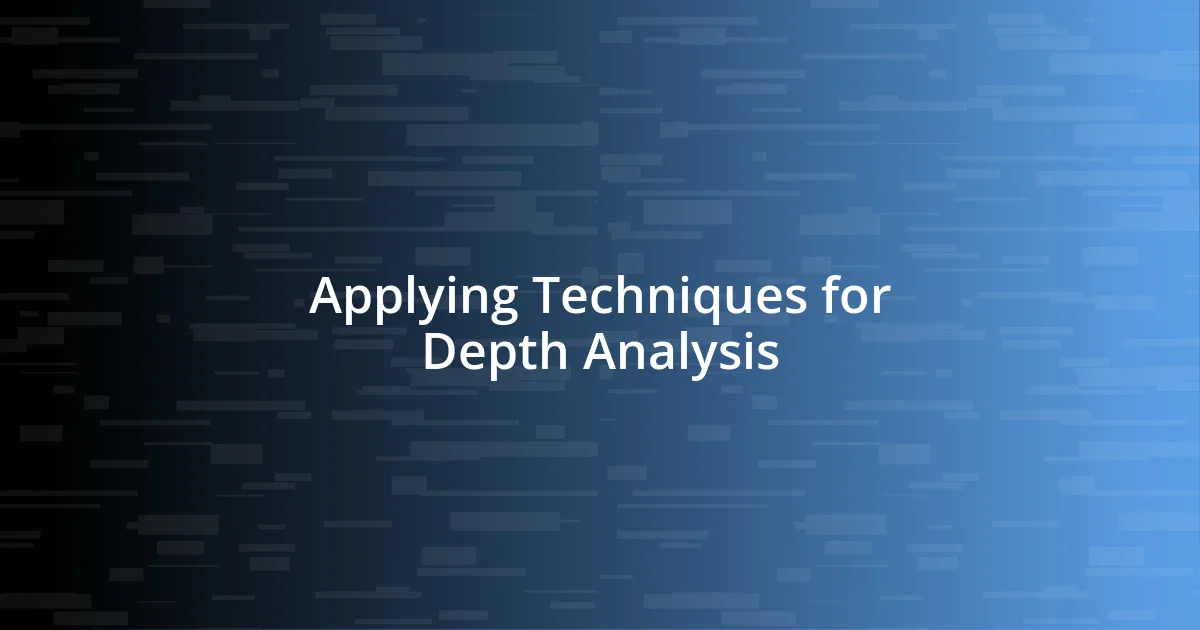Key takeaways:
- Dialogue reveals character motivations and emotional complexities, where tone, subtext, and pauses provide deeper insights into relationships.
- The pacing and rhythm of dialogue significantly influence how interactions are perceived, enhancing tension or reflection within a narrative.
- Utilizing dialogue effectively can advance plot and character development simultaneously, creating a richer and more engaging storytelling experience.

Understanding Dialogue in Literature
When I dive into a novel, I often find myself captivated by the way characters interact through dialogue. It’s not just about what they say, but how they say it—their tone, rhythm, and choice of words can reveal so much about who they are. Have you ever paused to consider how a single line can shift your perception of a character? I know I have.
I remember reading a story where two characters shared a seemingly mundane conversation, yet the subtext hinted at years of unresolved tension. That moment made me realize how dialogue serves as a window into deeper emotional currents. It’s fascinating how a well-crafted exchange can encapsulate complex relationships, making the dialogue not just words, but a dance of emotion and intent.
Moreover, understanding the nuances of dialogue allows readers to connect more intimately with the characters’ journeys. When dialogue reveals vulnerability or conflict, we see ourselves reflected in the text. Just think about your favorite book—what are those lines that still resonate with you? For me, it’s those moments where words capture the essence of human experience, reminding me of my own relationships and struggles.

Identifying Character Motivations
Identifying character motivations often begins with analyzing the subtext within their dialogue. I find that what characters choose to say—or not say—can illuminate their desires, fears, and influences. For example, in a recent novel I read, a character’s evasiveness during a crucial conversation revealed their deep-seated fear of failure. It struck me how a single pause or a change in tone could signal a wealth of internal conflict.
When I examine dialogue, I also look for patterns in how characters resonate with each other. Often, the motivations behind their words reflect relationships and past experiences. I remember a scene where a character offered a compliment that felt insincere at first glance, but subsequent revelations painted a clearer picture of their jealousy. It was a vivid reminder that even seemingly benign remarks can carry heavy emotional weight and reveal complex motivations.
In my experience, paying attention to the emotional stakes in dialogue has been crucial. Motivations are often tied to heightened emotions, whether it’s love, anger, or desperation. I reflect on a dialogue exchange between friends, where one person’s strained tone and clipped responses unveiled their disappointment and desire for validation. Understanding these nuances not only enriches the reading experience but also connects us to the characters on a deeper level.
| Dialogue Clue | Character Motivation |
|---|---|
| Vagueness or Evasiveness | Fear of revealing true feelings |
| Compliments with a tense undertone | Jealousy or insecurities |
| Emotional tone shifts | Underlying disappointment or need for approval |

Analyzing Subtext in Conversations
Analyzing the subtext in conversations reveals layers of meaning that often go unnoticed at first glance. I’ve encountered instances in stories where characters appear to engage in light banter, yet underlying tensions create a palpable sense of unease. For example, I once read a scene where two friends joked about a past event, but the nervous laughter made it clear there was something unresolved beneath the surface. These subtle cues in their dialogue helped me appreciate the complexity of their friendship and the unresolved conflict lying just out of view.
When dissecting subtext, it often boils down to the unsaid things—the pauses, the hesitations, and the emotional undertones. Here are a few elements that can signal deeper meanings in conversations:
- Silences: Moments of quiet can speak volumes, suggesting discomfort or unspoken thoughts.
- Word Choice: The specific words chosen can hint at underlying fears or desires, like how a character might refer to an ex-partner with a loaded phrase instead of a neutral term.
- Repetition: If a character keeps circling back to a particular topic, it may indicate emotional stakes they are grappling with.
- Contradictions: When what a character says conflicts with their body language or previous statements, it often reveals deeper motivations or fears.
- Subtle Modulations in Tone: A slight change in how something is said can shift the entire meaning of a statement, suggesting a hidden agenda or emotional struggle.
These elements remind me of the time I noticed a friend delivering a compliment with a half-hearted smile. The words were kind, but the underlying tension revealed a deeper story about envy and unfulfilled aspirations. Analyzing conversations through this lens allows me to engage with the text on an emotional level, ultimately enriching my understanding of the characters’ journeys.

Examining Dialogue Pacing and Rhythm
Examining the pacing and rhythm of dialogue can truly transform how we perceive character interactions. I remember reading a novel where a heated argument between two protagonists unfolded in rapid-fire exchanges. Each line seemed to tumble over the last, creating an electric tension that mirrored their escalating emotions. This experience made me realize how dialogue can pace a scene—either heightening suspense or allowing for a more reflective moment. Have you ever felt that shift when reading dialogue that flows effortlessly, pulling you further into the story?
There’s something intriguing about how pauses within dialogue can evoke emotion without a single word being spoken. I once dissected a conversation between a father and daughter, where meaningful silences punctuated their exchanges. The way they hesitated before certain topics revealed their discomfort and unaddressed feelings. Those quiet momentary gaps added a richness to the dialogue that spoke volumes about their relationship dynamics. It got me thinking, how often do I overlook these small pauses when evaluating conversations?
Moreover, the rhythm of dialogue often reflects the emotional stakes involved. I recall a scene where characters exchanged playful banter, but the leisurely back-and-forth was undercut by a lingering sense of fear about an impending disaster. This contrast created an engaging rhythm; the timing allowed humor to coexist with tension. It struck me how balancing different tempos can give depth to dialogues, making them resonate on multiple levels. Have you noticed how the rhythm can change the entire vibe of a conversation? It’s fascinating to see how pacing can reveal just as much as the words themselves.

Evaluating Realism in Character Speech
Evaluating the realism in character speech is crucial for crafting believable narratives. I once watched a film where two detectives chatted over coffee, and their conversation felt so genuine that I could almost hear the clatter of their mugs. It was the small details—the way they used jargon, their casual interruptions, and even their shared laughter—that brought their relationship to life. Have you ever listened closely to a conversation and thought, “That sounds just like how my friends talk”? It’s those relatable nuances that ground characters in reality.
In my experience, authenticity in dialogue often hinges on how well characters communicate their backgrounds and individual experiences. I remember reading a story where a character from a rural town spoke in a rich, regional dialect, filled with idioms and expressions that painted a vivid picture of their upbringing. The way they articulated ideas revealed their history and the cultural influences shaping their perspective. It made me think—how often do we overlook the significance of a character’s background in their speech? Recognizing these subtleties can deepen our understanding of who they are.
Then there are the moments when dialogue strays into the realm of the unbelievable. I encountered a character in a mystery novel who spouted complex legal jargon as a casual remark, which felt forced and disconnected from their personality. It left me questioning the writer’s choices. Shouldn’t speech reflect a character’s true self, instead of being a narrative device? Addressing these discrepancies not only enhances realism but also creates a richer connection for readers who yearn for genuine portrayals in storytelling.

Utilizing Dialogue to Advance Plot
Utilizing dialogue to propel the plot is an art form that I’ve found can dramatically enhance a story’s flow. I recall a particularly gripping novel where characters hinted at critical secrets through their conversations, enticing me to read on just to uncover the truth. It made me wonder—how often does a well-placed line of dialogue act as a breadcrumb, leading us deeper into the narrative? I’ve seen this technique inspire a sense of urgency, as if every exchanged word was a step closer to the climax.
Moreover, dialogue can serve as a powerful tool for revealing character motivations and advancing conflicts. I once analyzed a screenplay where a seemingly mundane conversation about dinner plans escalated into a revelation about deep-seated resentments. The characters’ struggle unfolded seamlessly—not just in what they were saying, but how they said it. It’s eye-opening to realize that a single dialogue choice can ignite tension or resolution. Have you ever noticed how a casual chat can suddenly shift gears, unveiling layers of complexity? It’s moments like these that keep me engaged and eager for what lies ahead.
What truly fascinates me is how dialogue can facilitate both character development and plot progression simultaneously. I was captivated while reading a story where two rivals were forced to collaborate, and their banter revealed their contrasting philosophies, directly influencing pivotal plot decisions. It seemed almost magical how the dialogue wasn’t just filler; it actively shaped their journey. Reflecting on this, I ask myself—what opportunities might I overlook when writing dialogue? By being mindful of how conversations advance not just the narrative but the characters themselves, there’s a wealth of depth waiting to be explored.

Applying Techniques for Depth Analysis
One effective technique I often apply is the “subtext” approach, where characters say one thing but mean another. I once read a gripping exchange in a play where two siblings navigated a sensitive topic about their parents. On the surface, they discussed a casual family dinner, but the tension simmering beneath revealed deeper issues—regrets, conflicts, and unspoken love. It’s fascinating how layers of meaning can be embedded in words; have you ever felt that tug between what’s said and what’s truly felt in your conversations?
Incorporating pauses and non-verbal cues is another technique I find deeply impactful. I remember analyzing a scene in a television series where a couple’s silence spoke volumes, each pause punctuated by unshed tears or heavy sighs. Instead of merely relying on dialogue, those moments lent depth and vulnerability to their relationship. It made me think—how often do we overlook the unsaid aspects in our own exchanges? These pauses can truly transform a dialogue from mundane to profound.
Finally, varying the rhythm and pacing of dialogue can create a dynamic tension that captivates the audience. I was struck by a novel where rapid-fire exchanges between characters mirrored their rising anxiety, while slower, deliberate speech indicated moments of reflection. The contrasting rhythms not only conveyed their emotional states but also heightened the stakes of their interactions. Isn’t it incredible how the tempo of speech can elevate a scene’s emotional intensity? I believe being conscious of these techniques can significantly enrich dialogue, leading to more compelling narratives.














